Prehistoric and ancient Japan
Paleolithic period
Hunter-gatherers arrived in Japan inJōmon period
 The Jōmon period of prehistoric Japan spans from roughly 13,000 BC to about 1,000 BC. Japan was inhabited by a predominantly
The Jōmon period of prehistoric Japan spans from roughly 13,000 BC to about 1,000 BC. Japan was inhabited by a predominantly Yayoi period
The advent of the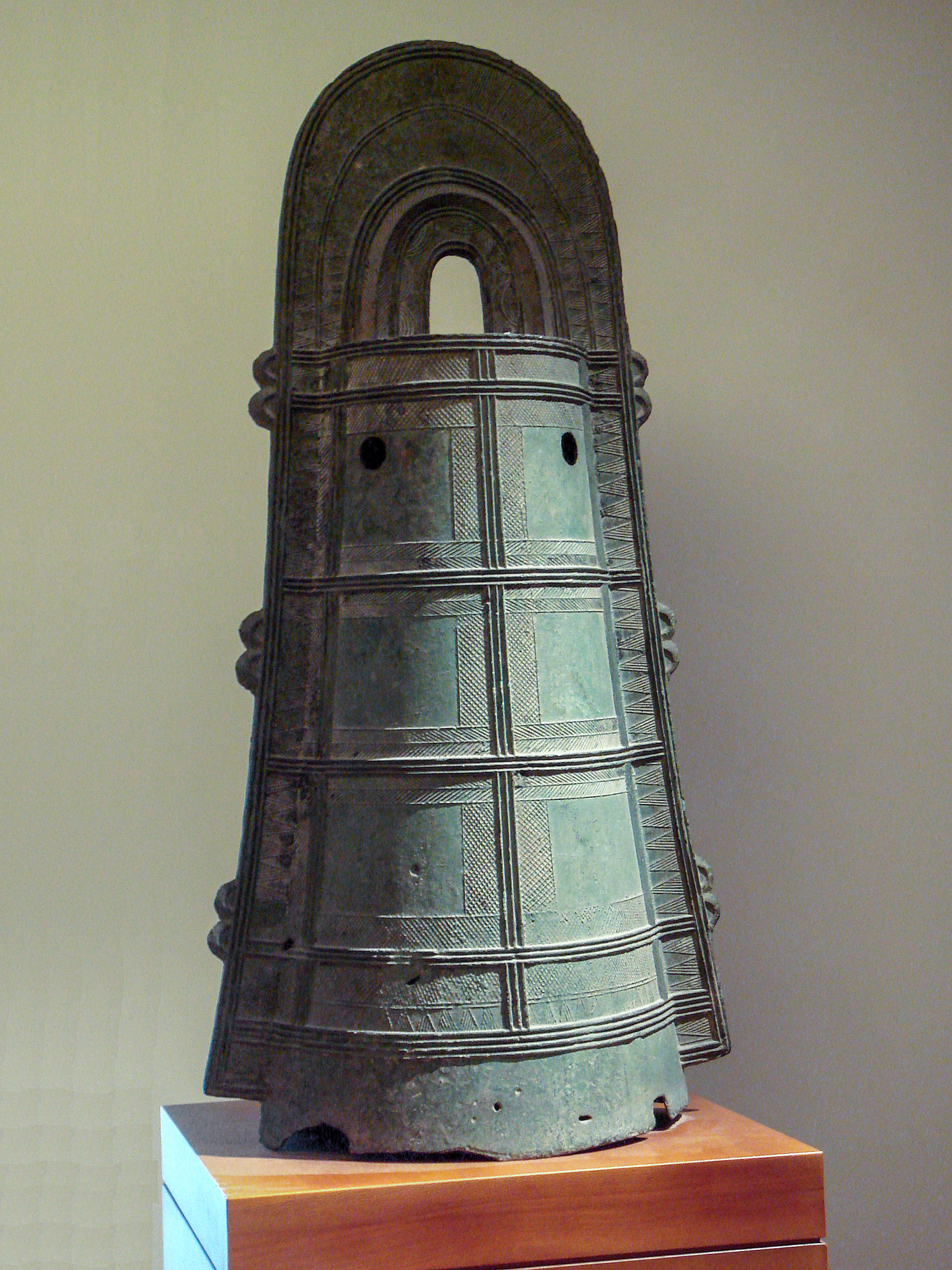 The Yayoi technologies originated on the Asian mainland. There is debate among scholars as to what extent their spread was accomplished by means of migration or simply a diffusion of ideas, or a combination of both. The migration theory is supported by genetic and linguistic studies. Historian Hanihara Kazurō has suggested that the annual immigrant influx from the continent range from 350 to 3,000.
The population of Japan began to increase rapidly, perhaps with a 10-fold rise over the Jōmon. Calculations of the population size have varied from 1 to 4 million by the end of the Yayoi. Skeletal remains from the late Jōmon period reveal a deterioration in already poor standards of health and nutrition, in contrast to Yayoi archaeological sites where there are large structures suggestive of grain storehouses. This change was accompanied by an increase in both the
The Yayoi technologies originated on the Asian mainland. There is debate among scholars as to what extent their spread was accomplished by means of migration or simply a diffusion of ideas, or a combination of both. The migration theory is supported by genetic and linguistic studies. Historian Hanihara Kazurō has suggested that the annual immigrant influx from the continent range from 350 to 3,000.
The population of Japan began to increase rapidly, perhaps with a 10-fold rise over the Jōmon. Calculations of the population size have varied from 1 to 4 million by the end of the Yayoi. Skeletal remains from the late Jōmon period reveal a deterioration in already poor standards of health and nutrition, in contrast to Yayoi archaeological sites where there are large structures suggestive of grain storehouses. This change was accompanied by an increase in both the Kofun period (c. 250–538)
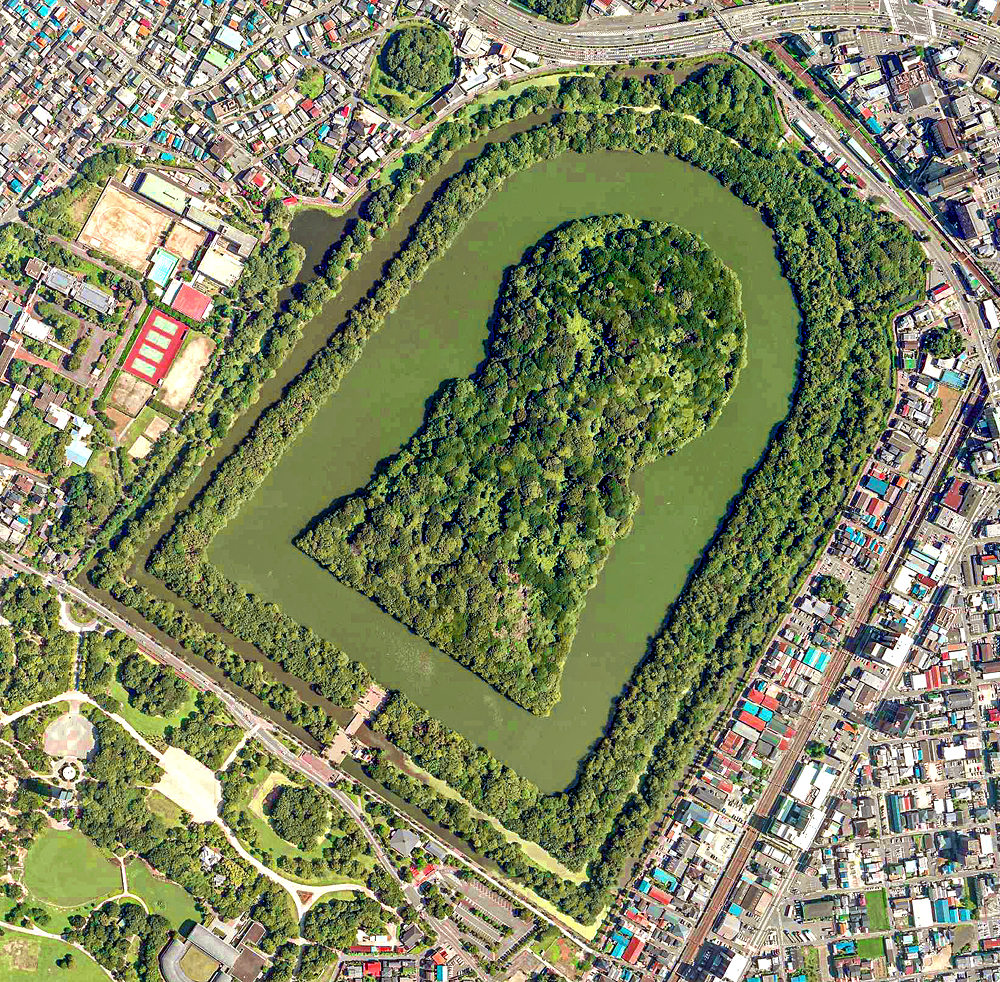 During the subsequent
During the subsequent 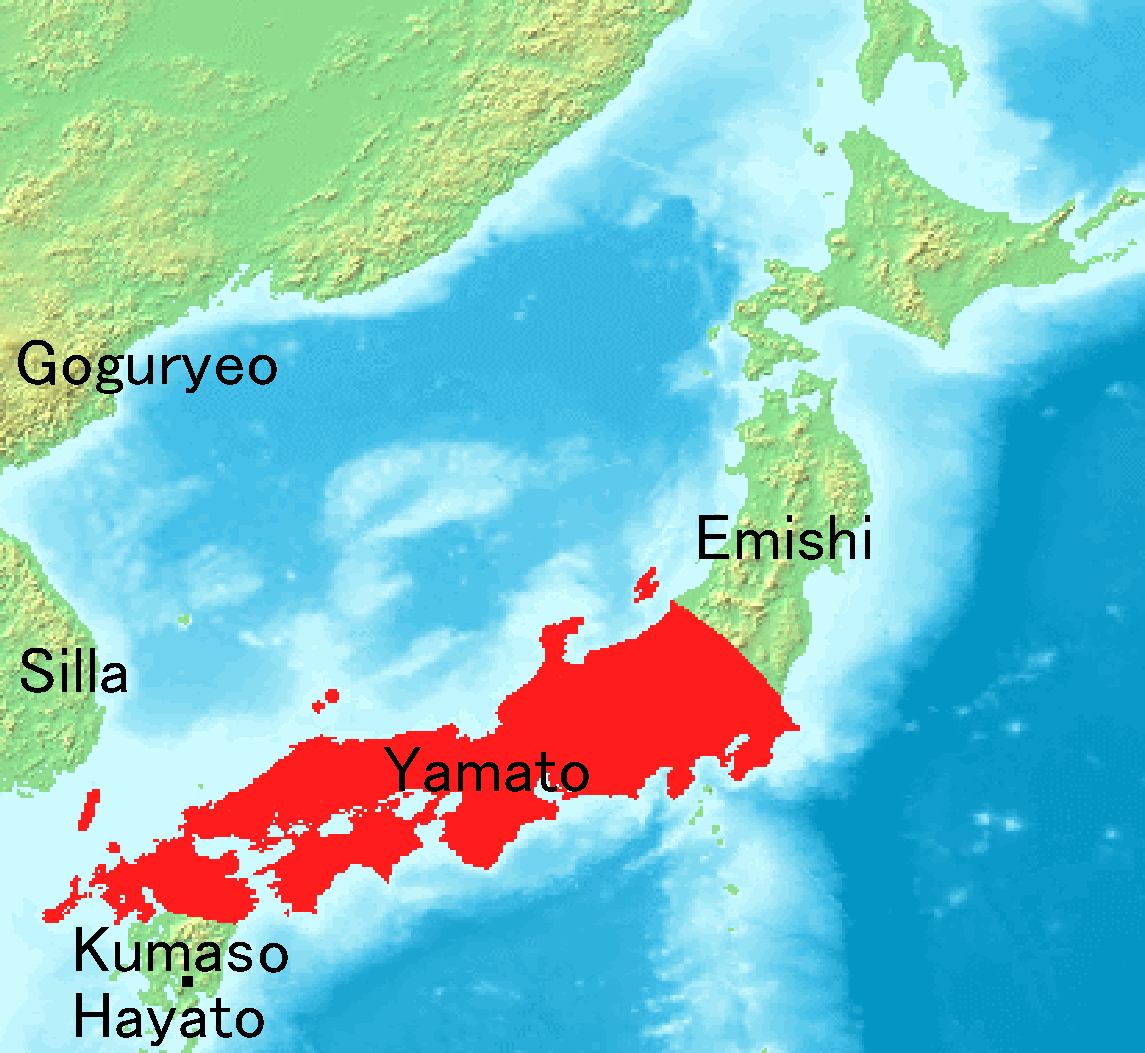 These leaders sought and received formal diplomatic recognition from China, and Chinese accounts record five successive such leaders as the
These leaders sought and received formal diplomatic recognition from China, and Chinese accounts record five successive such leaders as the Classical Japan
Asuka period (538–710)
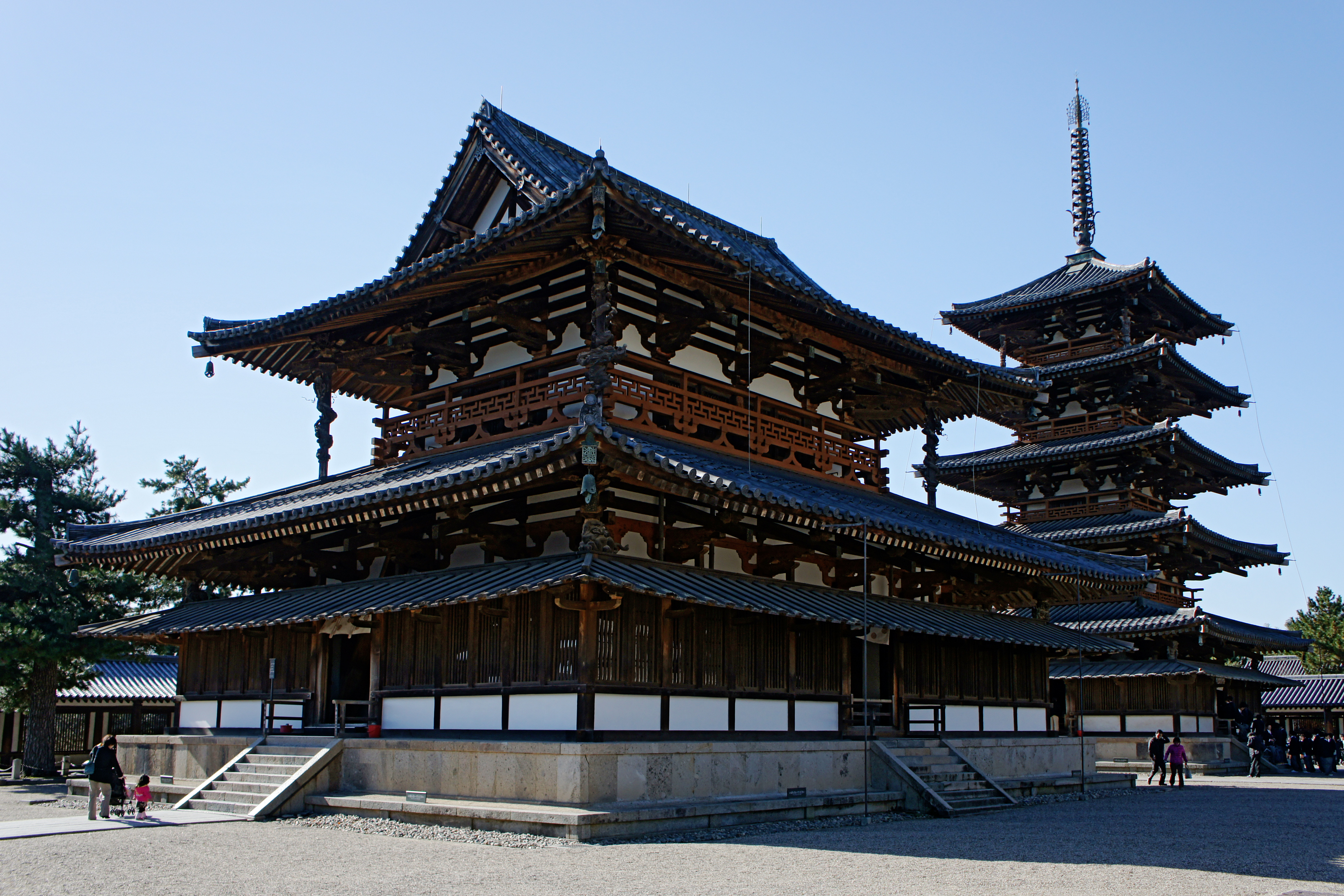 The
The 
 In 645, the Soga clan were overthrown in a coup launched by Prince Naka no Ōe and
In 645, the Soga clan were overthrown in a coup launched by Prince Naka no Ōe and Nara period (710–794)
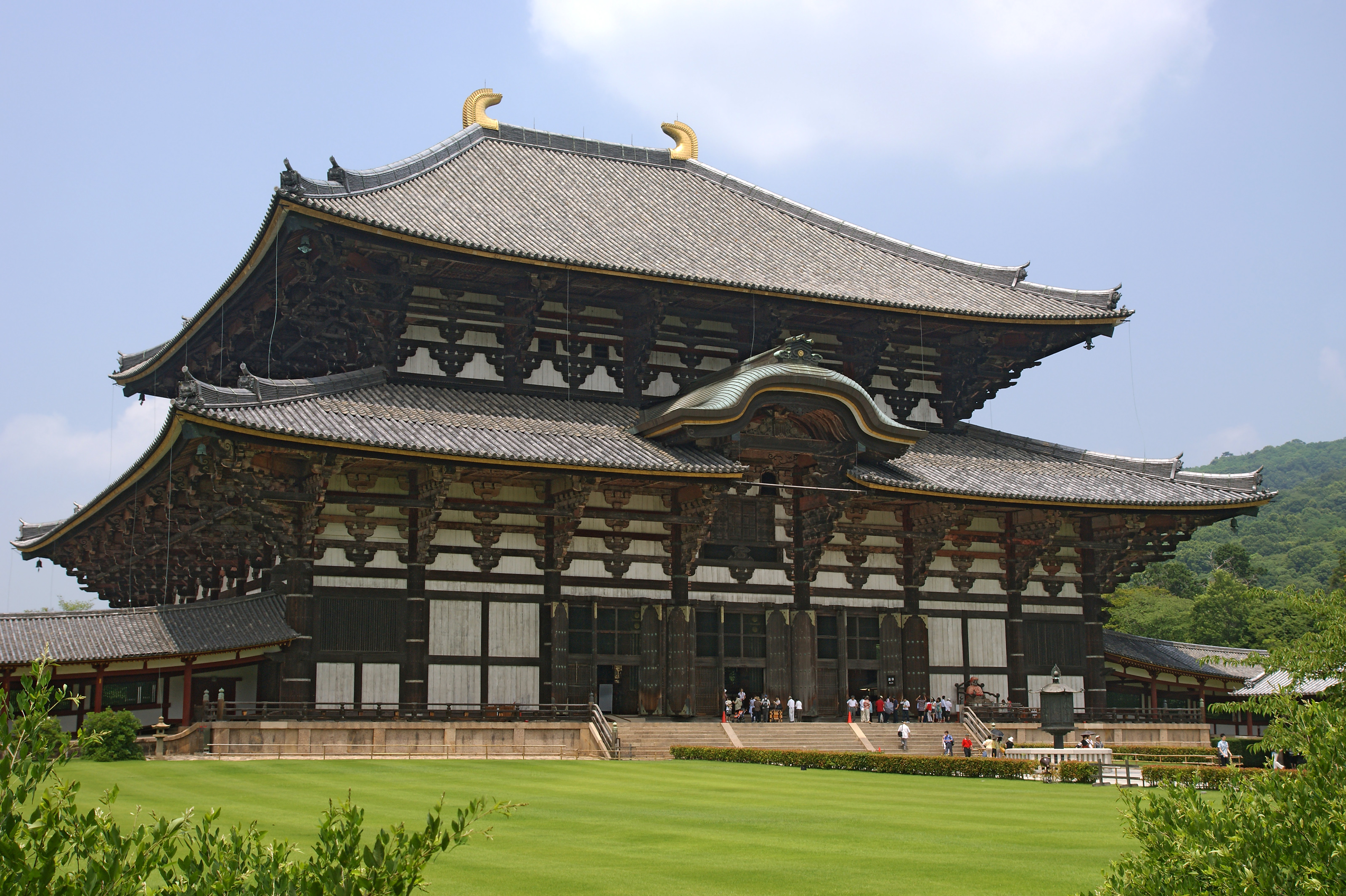 In 710, the government constructed a grandiose new capital at
In 710, the government constructed a grandiose new capital at Heian period (794–1185)

 In 784, the capital moved briefly to
In 784, the capital moved briefly to Heian culture
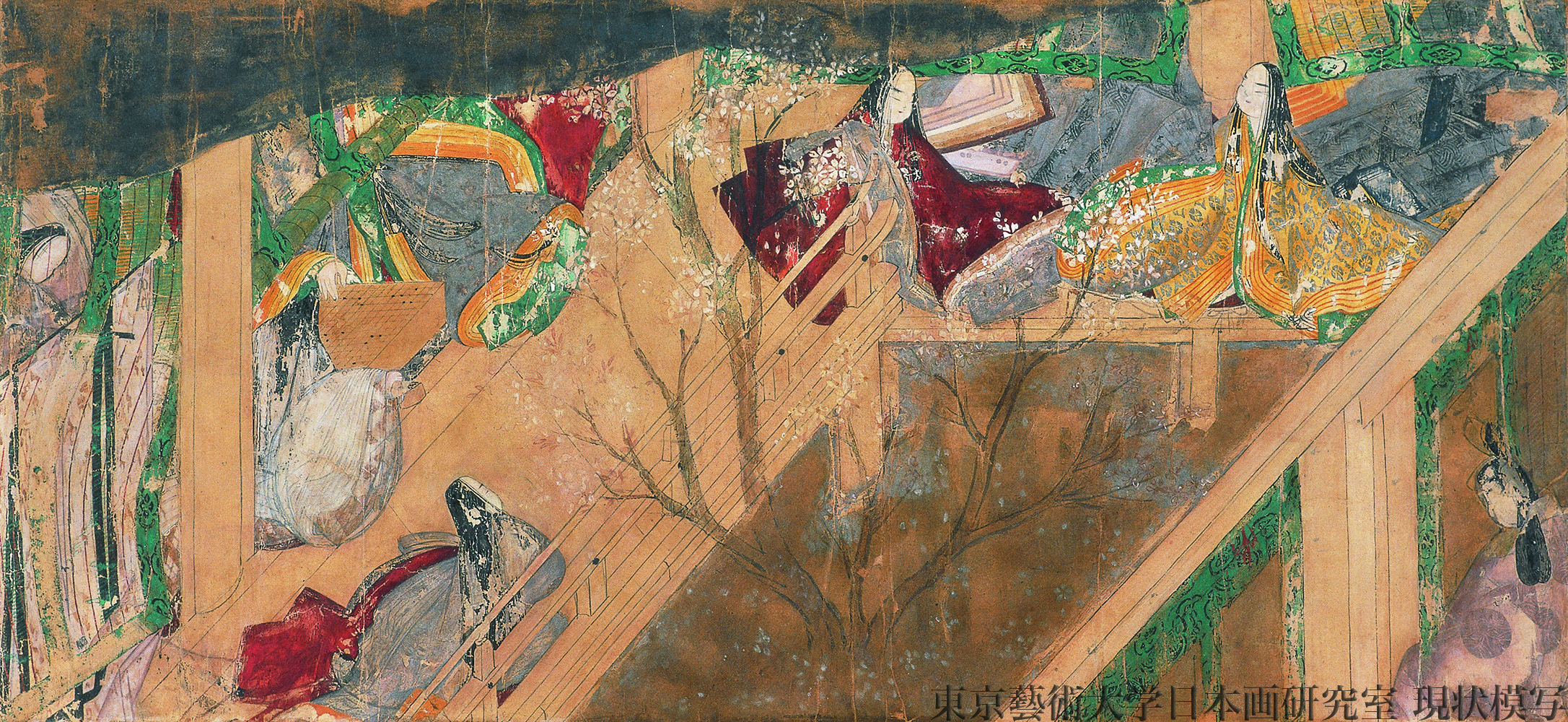 During the Heian period, the imperial court was a vibrant center of high art and culture. Its literary accomplishments include the poetry collection '' Kokinshū'' and the ''
During the Heian period, the imperial court was a vibrant center of high art and culture. Its literary accomplishments include the poetry collection '' Kokinshū'' and the ''Feudal Japan
Kamakura period (1185–1333)
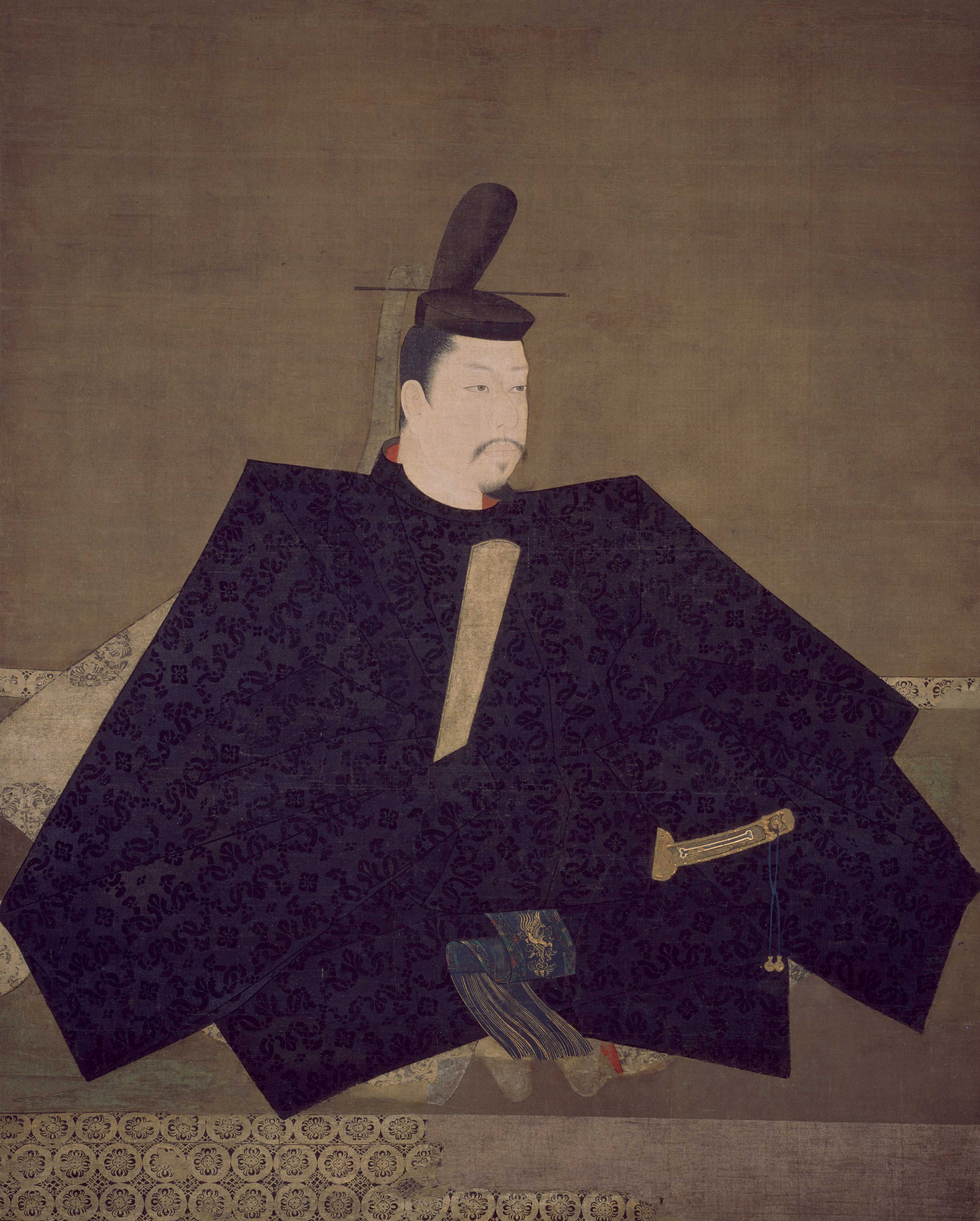 Upon the consolidation of power,
Upon the consolidation of power, Muromachi period (1333–1568)
 Takauji and many other samurai soon became dissatisfied with Emperor Go-Daigo's Kenmu Restoration, an ambitious attempt to monopolize power in the imperial court. Takauji rebeled after Go-Daigo refused to appoint him shōgun. In 1338, Takauji captured Kyoto and installed a rival member of the imperial family to the throne, Emperor Kōmyō, who did appoint him shogun. Go-Daigo responded by fleeing to the southern city of Yoshino, Nara, Yoshino, where he set up a rival government. This ushered in a prolonged Nanboku-chō period, period of conflict between the Northern Court and the Southern Court.
Takauji set up his shogunate in the Muromachi district of Kyoto. However, the shogunate was faced with the twin challenges of fighting the Southern Court and of maintaining its authority over its own subordinate governors. Like the Kamakura shogunate, the Muromachi shogunate appointed its allies to rule in the provinces, but these men increasingly styled themselves as feudal lords—called ''
Takauji and many other samurai soon became dissatisfied with Emperor Go-Daigo's Kenmu Restoration, an ambitious attempt to monopolize power in the imperial court. Takauji rebeled after Go-Daigo refused to appoint him shōgun. In 1338, Takauji captured Kyoto and installed a rival member of the imperial family to the throne, Emperor Kōmyō, who did appoint him shogun. Go-Daigo responded by fleeing to the southern city of Yoshino, Nara, Yoshino, where he set up a rival government. This ushered in a prolonged Nanboku-chō period, period of conflict between the Northern Court and the Southern Court.
Takauji set up his shogunate in the Muromachi district of Kyoto. However, the shogunate was faced with the twin challenges of fighting the Southern Court and of maintaining its authority over its own subordinate governors. Like the Kamakura shogunate, the Muromachi shogunate appointed its allies to rule in the provinces, but these men increasingly styled themselves as feudal lords—called ''
Nanban trade
Amid this on-going anarchy, a trading ship was blown off course and landed in 1543 on the Japanese island of Tanegashima, just south of Kyushu. The three Portugal, Portuguese traders on board were the first Europeans to set foot in Japan. Soon European traders would introduce many new items to Japan, most importantly the musket. By 1556, the ''daimyōs'' were using about 300,000 muskets in their armies. The Europeans also History of Roman Catholicism in Japan, brought Christianity, which soon came to have a substantial following in Japan reaching 350,000 believers. In 1549 the Society of Jesus, Jesuit missionary Francis Xavier disembarked in Kyushu. Initiating direct Nanban trade, commercial and Nanban art, cultural exchange between Japan and the West, the first map made of Japan in the west was represented in 1568 by the Portuguese cartographer Fernão Vaz Dourado.
The Portuguese were allowed to trade and create colonies where they could convert new believers into the Christian religion. The civil war status in Japan greatly benefited the Portuguese, as well as several competing gentlemen who sought to attract Portuguese black boats and their trade to their domains. Initially, the Portuguese stayed on the lands belonging to Matsura Takanobu, Firando (Hirado), and in the province of Bungo, lands of Ōtomo Sōrin, but in 1562 they moved to Yokoseura when the Daimyô there, Omura Sumitada, offered to be the first lord to convert to Christianity, adopting the name of Dom Bartolomeu. In 1564, he faced a rebellion instigated by the Buddhist clergy and Yokoseura was destroyed.
In 1561 forces under Ōtomo Sōrin attacked the castle in Siege of Moji, Moji with an alliance with the Portuguese, who provided three ships, with a crew of about 900 men and more than 50 cannons. This is thought to be the first bombardment by foreign ships on Japan. The first recorded naval battle between Europeans and the Japanese occurred in 1565. In the Battle of Fukuda Bay, the ''
Initiating direct Nanban trade, commercial and Nanban art, cultural exchange between Japan and the West, the first map made of Japan in the west was represented in 1568 by the Portuguese cartographer Fernão Vaz Dourado.
The Portuguese were allowed to trade and create colonies where they could convert new believers into the Christian religion. The civil war status in Japan greatly benefited the Portuguese, as well as several competing gentlemen who sought to attract Portuguese black boats and their trade to their domains. Initially, the Portuguese stayed on the lands belonging to Matsura Takanobu, Firando (Hirado), and in the province of Bungo, lands of Ōtomo Sōrin, but in 1562 they moved to Yokoseura when the Daimyô there, Omura Sumitada, offered to be the first lord to convert to Christianity, adopting the name of Dom Bartolomeu. In 1564, he faced a rebellion instigated by the Buddhist clergy and Yokoseura was destroyed.
In 1561 forces under Ōtomo Sōrin attacked the castle in Siege of Moji, Moji with an alliance with the Portuguese, who provided three ships, with a crew of about 900 men and more than 50 cannons. This is thought to be the first bombardment by foreign ships on Japan. The first recorded naval battle between Europeans and the Japanese occurred in 1565. In the Battle of Fukuda Bay, the '' In 1571, Dom Bartolomeu, also known as Ōmura Sumitada, guaranteed a little land in the small fishing village of "Nagasáqui" to the Jesuits, who divided it into six areas. They could use the land to receive Christians exiled from other territories, as well as for Portuguese merchants. The Jesuits built a chapel and a school under the name of São Paulo, like those in Goa and Malacca. By 1579, Nagasáqui had four hundred houses, and some Portuguese had gotten married. Fearful that Nagasaki could fall into the hands of its rival Takanobu, Omura Sumitada (Dom Bartolomeu) decided to guarantee the city directly to the Jesuits in 1580. After a few years, the Jesuits came to realize that if they understood the language they would achieve more conversions to the Catholic religion. Jesuits such as João Rodrigues wrote a Nippo jisho, Japanese dictionary. Thus Portuguese became the first Western language to have such a dictionary when it was published in Nagasaki in 1603.
In 1571, Dom Bartolomeu, also known as Ōmura Sumitada, guaranteed a little land in the small fishing village of "Nagasáqui" to the Jesuits, who divided it into six areas. They could use the land to receive Christians exiled from other territories, as well as for Portuguese merchants. The Jesuits built a chapel and a school under the name of São Paulo, like those in Goa and Malacca. By 1579, Nagasáqui had four hundred houses, and some Portuguese had gotten married. Fearful that Nagasaki could fall into the hands of its rival Takanobu, Omura Sumitada (Dom Bartolomeu) decided to guarantee the city directly to the Jesuits in 1580. After a few years, the Jesuits came to realize that if they understood the language they would achieve more conversions to the Catholic religion. Jesuits such as João Rodrigues wrote a Nippo jisho, Japanese dictionary. Thus Portuguese became the first Western language to have such a dictionary when it was published in Nagasaki in 1603.
Muromachi culture
In spite of the war, Japan's relative economic prosperity, which had begun in the Kamakura period, continued well into the Muromachi period. By 1450 Japan's population stood at ten million, compared to six million at the end of the thirteenth century. Commerce flourished, including considerable trade with China and Korea. Because the ''daimyōs'' and other groups within Japan were minting their own coins, Japan began to transition from a barter-based to a currency-based economy. During the period, some of Japan's most representative art forms developed, including ink wash painting, ''ikebana'' flower arrangement, the tea ceremony, Japanese gardening, ''bonsai'', and ''Noh'' theater. Though the eighth Ashikaga shogun, Ashikaga Yoshimasa, Yoshimasa, was an ineffectual political and military leader, he played a critical role in promoting these cultural developments. He had the famous Kinkaku-ji or "Temple of the Golden Pavilion" built in Kyoto in 1397.Azuchi–Momoyama period (1568-1600)
 During the second half of the 16th century, Japan gradually reunified under two powerful warlords: Oda Nobunaga and
During the second half of the 16th century, Japan gradually reunified under two powerful warlords: Oda Nobunaga and 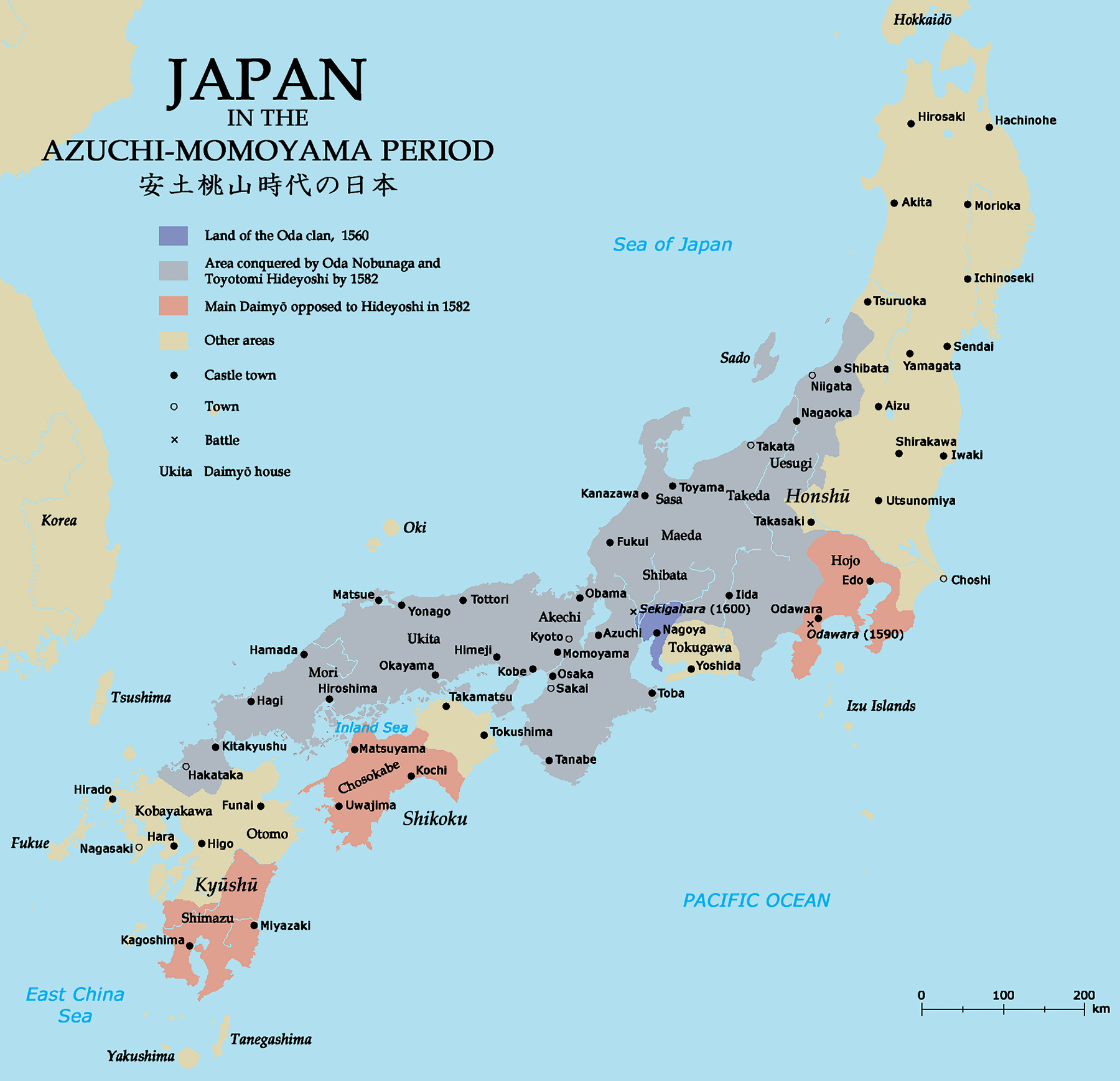 Nobunaga was the ''daimyō'' of the small province of Owari Province, Owari. He burst onto the scene suddenly, in 1560, when, during the Battle of Okehazama, his army defeated a force several times its size led by the powerful ''daimyō'' Imagawa Yoshimoto. Nobunaga was renowned for his strategic leadership and his ruthlessness. He encouraged Christianity to incite hatred toward his Buddhist enemies and to forge strong relationships with European arms merchants. He equipped his armies with muskets and trained them with innovative tactics. He promoted talented men regardless of their social status, including his peasant servant Toyotomi Hideyoshi, who became one of his best generals.
The Azuchi–Momoyama period began in 1568, when Nobunaga seized Kyoto and thus effectively brought an end to the Ashikaga shogunate. He was well on his way towards his goal of reuniting all Japan in 1582 when one of his own officers, Akechi Mitsuhide, killed him during an abrupt attack on his encampment. Hideyoshi avenged Nobunaga by crushing Akechi's uprising and emerged as Nobunaga's successor. Hideyoshi completed the reunification of Japan by conquering Shikoku, Kyushu, and the lands of the Late Hōjō clan, Hōjō family in eastern Japan. He launched sweeping changes to Japanese society, including the confiscation of swords from the peasantry, new restrictions on ''daimyōs'', persecutions of Christians, a thorough land survey, and a new law effectively forbidding the peasants and samurai from changing their social class. Hideyoshi's land survey designated all those who were cultivating the land as being "commoners", an act which effectively granted freedom to most of Japan's Slavery in Japan, slaves.
As Hideyoshi's power expanded, he dreamed of conquering China and launched two massive Japanese invasions of Korea (1592–98), invasions of Korea starting in 1592. Hideyoshi failed to defeat the Chinese and Korean armies on the Korean Peninsula and the war ended after his death in 1598. In the hope of founding a new dynasty, Hideyoshi had asked his most trusted subordinates to pledge loyalty to his infant son Toyotomi Hideyori. Despite this, almost immediately after Hideyoshi's death, war broke out between Hideyori's allies and those loyal to
Nobunaga was the ''daimyō'' of the small province of Owari Province, Owari. He burst onto the scene suddenly, in 1560, when, during the Battle of Okehazama, his army defeated a force several times its size led by the powerful ''daimyō'' Imagawa Yoshimoto. Nobunaga was renowned for his strategic leadership and his ruthlessness. He encouraged Christianity to incite hatred toward his Buddhist enemies and to forge strong relationships with European arms merchants. He equipped his armies with muskets and trained them with innovative tactics. He promoted talented men regardless of their social status, including his peasant servant Toyotomi Hideyoshi, who became one of his best generals.
The Azuchi–Momoyama period began in 1568, when Nobunaga seized Kyoto and thus effectively brought an end to the Ashikaga shogunate. He was well on his way towards his goal of reuniting all Japan in 1582 when one of his own officers, Akechi Mitsuhide, killed him during an abrupt attack on his encampment. Hideyoshi avenged Nobunaga by crushing Akechi's uprising and emerged as Nobunaga's successor. Hideyoshi completed the reunification of Japan by conquering Shikoku, Kyushu, and the lands of the Late Hōjō clan, Hōjō family in eastern Japan. He launched sweeping changes to Japanese society, including the confiscation of swords from the peasantry, new restrictions on ''daimyōs'', persecutions of Christians, a thorough land survey, and a new law effectively forbidding the peasants and samurai from changing their social class. Hideyoshi's land survey designated all those who were cultivating the land as being "commoners", an act which effectively granted freedom to most of Japan's Slavery in Japan, slaves.
As Hideyoshi's power expanded, he dreamed of conquering China and launched two massive Japanese invasions of Korea (1592–98), invasions of Korea starting in 1592. Hideyoshi failed to defeat the Chinese and Korean armies on the Korean Peninsula and the war ended after his death in 1598. In the hope of founding a new dynasty, Hideyoshi had asked his most trusted subordinates to pledge loyalty to his infant son Toyotomi Hideyori. Despite this, almost immediately after Hideyoshi's death, war broke out between Hideyori's allies and those loyal to Early modern Japan
Edo period (1600–1868)
Culture and philosophy
 The Edo period was a time of cultural flourishing, as the merchant classes grew in wealth and began spending their income on cultural and social pursuits. Members of the merchant class who patronized culture and entertainment were said to live hedonistic lives, which came to be called the ''ukiyo'' ("floating world"). This lifestyle inspired ''ukiyo-zōshi'' popular novels and ''ukiyo-e'' art, the latter of which were often woodblock prints that progressed to greater sophistication and use of Nishiki-e, multiple printed colors.
Forms of theater such as kabuki and ''bunraku'' puppet theater became widely popular. These new forms of entertainment were (at the time) accompanied by short songs (''kouta'') and music played on the ''shamisen'', a new import to Japan in 1600. ''Haiku'', whose greatest master is generally agreed to be Matsuo Bashō (1644–1694), also rose as a major form of poetry. Geisha, a new profession of entertainers, also became popular. They would provide conversation, sing, and dance for customers, though they would not sleep with them.
The Tokugawas sponsored and were heavily influenced by Neo-Confucianism, which led the government to divide society into four classes based on the four occupations. The samurai class claimed to follow the ideology of bushido, literally "the way of the warrior".
The Edo period was a time of cultural flourishing, as the merchant classes grew in wealth and began spending their income on cultural and social pursuits. Members of the merchant class who patronized culture and entertainment were said to live hedonistic lives, which came to be called the ''ukiyo'' ("floating world"). This lifestyle inspired ''ukiyo-zōshi'' popular novels and ''ukiyo-e'' art, the latter of which were often woodblock prints that progressed to greater sophistication and use of Nishiki-e, multiple printed colors.
Forms of theater such as kabuki and ''bunraku'' puppet theater became widely popular. These new forms of entertainment were (at the time) accompanied by short songs (''kouta'') and music played on the ''shamisen'', a new import to Japan in 1600. ''Haiku'', whose greatest master is generally agreed to be Matsuo Bashō (1644–1694), also rose as a major form of poetry. Geisha, a new profession of entertainers, also became popular. They would provide conversation, sing, and dance for customers, though they would not sleep with them.
The Tokugawas sponsored and were heavily influenced by Neo-Confucianism, which led the government to divide society into four classes based on the four occupations. The samurai class claimed to follow the ideology of bushido, literally "the way of the warrior".
Decline and fall of the shogunate
By the late eighteenth and early nineteenth centuries, the shogunate showed signs of weakening. The dramatic growth of agriculture that had characterized the early Edo period had ended, and the government handled the devastating Tenpō famines poorly. Peasant unrest grew and government revenues fell. The shogunate cut the pay of the already financially distressed samurai, many of whom worked side jobs to make a living. Discontented samurai were soon to play a major role in engineering the downfall of the Tokugawa shogunate. At the same time, the people drew inspiration from new ideas and fields of study. Dutch books brought into Japan stimulated interest in Western learning, called ''rangaku'' or "Dutch learning". The physician Sugita Genpaku, for instance, used concepts from Western medicine to help spark a revolution in Japanese ideas of human anatomy. The scholarly field of ''kokugaku'' or "national learning", developed by scholars such as Motoori Norinaga and Hirata Atsutane, promoted what it asserted were native Japanese values. For instance, it criticized the Chinese-style Neo-Confucianism advocated by the shogunate and emphasized the Emperor's divine authority, which the Shinto faith taught had its roots in Japan's mythic past, which was referred to as the "Age of the Gods". The arrival in 1853 of a fleet of American ships commanded by Commodore Matthew C. Perry threw Japan into turmoil. The Federal government of the United States, US government aimed to end Japan's isolationist policies. The shogunate had no defense against Perry's gunboats and had to agree to his demands that American ships be permitted to acquire provisions and trade at Japanese ports. The Western world, Western powers imposed what became known as "Unequal treaty, unequal treaties" on Japan which stipulated that Japan must allow citizens of these countries to visit or reside on Japanese territory and must not levy tariffs on their imports or try them in Japanese courts.
The shogunate's failure to oppose the Western powers angered many Japanese, particularly those of the southern domains of Chōshū Domain, Chōshū and Satsuma Domain, Satsuma. Many samurai there, inspired by the nationalist doctrines of the kokugaku school, adopted the slogan of ''sonnō jōi'' ("revere the emperor, expel the barbarians"). The two domains went on to form an alliance. In August 1866, soon after becoming shogun, Tokugawa Yoshinobu, struggled to maintain power as civil unrest continued. The Chōshū and Satsuma domains in 1868 convinced the young Emperor Meiji and his advisors to issue a rescript calling for an end to the Tokugawa shogunate. The armies of Chōshū and Satsuma soon marched on Edo and the ensuing
The arrival in 1853 of a fleet of American ships commanded by Commodore Matthew C. Perry threw Japan into turmoil. The Federal government of the United States, US government aimed to end Japan's isolationist policies. The shogunate had no defense against Perry's gunboats and had to agree to his demands that American ships be permitted to acquire provisions and trade at Japanese ports. The Western world, Western powers imposed what became known as "Unequal treaty, unequal treaties" on Japan which stipulated that Japan must allow citizens of these countries to visit or reside on Japanese territory and must not levy tariffs on their imports or try them in Japanese courts.
The shogunate's failure to oppose the Western powers angered many Japanese, particularly those of the southern domains of Chōshū Domain, Chōshū and Satsuma Domain, Satsuma. Many samurai there, inspired by the nationalist doctrines of the kokugaku school, adopted the slogan of ''sonnō jōi'' ("revere the emperor, expel the barbarians"). The two domains went on to form an alliance. In August 1866, soon after becoming shogun, Tokugawa Yoshinobu, struggled to maintain power as civil unrest continued. The Chōshū and Satsuma domains in 1868 convinced the young Emperor Meiji and his advisors to issue a rescript calling for an end to the Tokugawa shogunate. The armies of Chōshū and Satsuma soon marched on Edo and the ensuing Modern Japan
Meiji period (1868–1912)
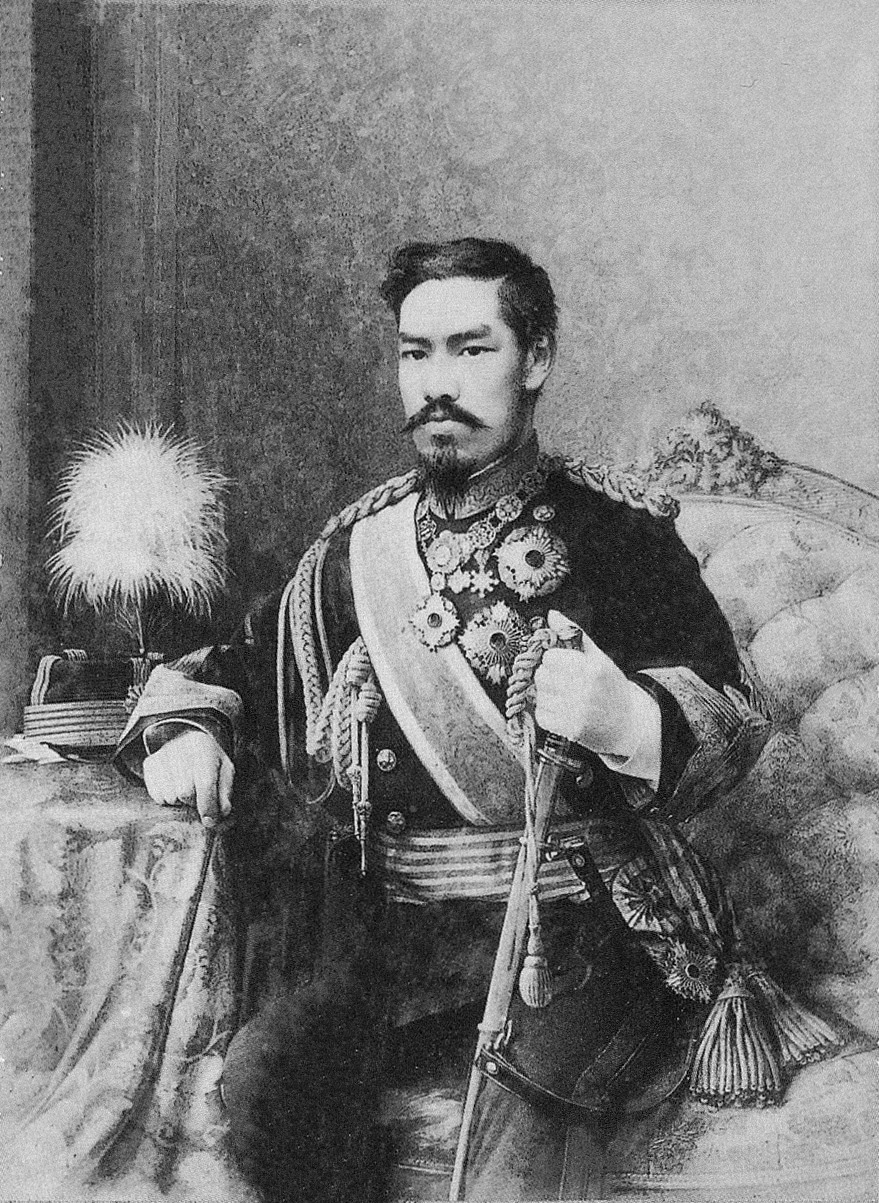 The emperor was restored to nominal supreme power, and in 1869, the imperial family moved to Edo, which was renamed
The emperor was restored to nominal supreme power, and in 1869, the imperial family moved to Edo, which was renamed Political and social changes
The Meiji government abolished the Edo class structure and replaced the feudal domains of the ''daimyōs'' with Prefectures of Japan, prefectures. It instituted comprehensive tax reform and lifted the ban on Christianity. Major government priorities also included the introduction of railways, telegraph lines, and a universal education system. The Meiji government promoted widespread Westernization and hired hundreds of Foreign government advisors in Meiji Japan, advisers from Western nations with expertise in such fields as education, mining, banking, law, military affairs, and transportation to remodel Japan's institutions. The Japanese adopted the Gregorian calendar, Western clothing, and Western hairstyles. One leading advocate of Westernization was the popular writer Fukuzawa Yukichi. As part of its Westernization drive, the Meiji government enthusiastically sponsored the importation of Western science, above all medical science. In 1893, Kitasato Shibasaburō established the Institute for Infectious Diseases, which would soon become world-famous, and in 1913, Hideyo Noguchi proved the link between syphilis and paresis. Furthermore, the introduction of European literary styles to Japan sparked a boom in new works of prose fiction. Characteristic authors of the period included Futabatei Shimei and Mori Ōgai, although the most famous of the Meiji era writers was Natsume Sōseki, who wrote satirical, autobiographical, and psychological novels combining both the older and newer styles. Ichiyō Higuchi, a leading female author, took inspiration from earlier literary models of the Edo period. Government institutions developed rapidly in response to the Freedom and People's Rights Movement, a grassroots campaign demanding greater popular participation in politics. The leaders of this movement included Itagaki Taisuke and Ōkuma Shigenobu. Itō Hirobumi, the first Prime Minister of Japan, responded by writing the Meiji Constitution, which was promulgated in 1889. The new constitution established an elected lower house, the House of Representatives (Japan), House of Representatives, but its powers were restricted. Only two percent of the population were eligible to vote, and legislation proposed in the House required the support of the unelected upper house, the House of Peers (Japan), House of Peers. Both the cabinet of Japan and the Japanese military were directly responsible not to the elected legislature but to the emperor. Concurrently, the Japanese government also developed a form of Japanese nationalism under which State Shinto, Shinto became the state religion and the emperor was declared a living god. Schools nationwide instilled patriotic values and loyalty to the emperor.Rise of imperialism and the military
 In December 1871, a Ryukyuan ship was shipwrecked on Taiwan and the crew Mudan incident, were massacred. In 1874, using the incident as a pretext, Japan launched Japanese invasion of Taiwan (1874), a military expedition to Taiwan to assert their claims to the Ryukyu Islands. The expedition featured the first instance of the Japanese military ignoring the orders of the civilian government, as the expedition set sail after being ordered to postpone. Yamagata Aritomo, who was born a samurai in the Chōshū Domain, was a key force behind the modernization and enlargement of the Imperial Japanese Army, especially the introduction of national conscription. The new army was put to use in 1877 to crush the Satsuma Rebellion of discontented samurai in southern Japan led by the former Meiji leader Saigo Takamori.
The Japanese military played a key role in Japan's expansion abroad. The government believed that Japan had to acquire its own colonies to compete with the Western colonial powers. After consolidating its control over Hokkaido (through the Hokkaidō Development Commission) and annexing the Ryukyu Kingdom (the "Ryūkyū Disposition"), it next turned its attention to China and Korea. In 1894, Japanese and Chinese troops clashed in Korea, where they were both stationed to suppress the Donghak Rebellion. During the ensuing First Sino-Japanese War, Japan's highly motivated and well-led forces defeated the more numerous and better-equipped military of Qing China. The island of Taiwan was thus ceded to Japan in 1895, and Japan's government gained enough international prestige to allow Foreign Minister Mutsu Munemitsu to renegotiate the "unequal treaties". In 1902 Japan signed Anglo-Japanese Alliance, an important military alliance with the British.
In December 1871, a Ryukyuan ship was shipwrecked on Taiwan and the crew Mudan incident, were massacred. In 1874, using the incident as a pretext, Japan launched Japanese invasion of Taiwan (1874), a military expedition to Taiwan to assert their claims to the Ryukyu Islands. The expedition featured the first instance of the Japanese military ignoring the orders of the civilian government, as the expedition set sail after being ordered to postpone. Yamagata Aritomo, who was born a samurai in the Chōshū Domain, was a key force behind the modernization and enlargement of the Imperial Japanese Army, especially the introduction of national conscription. The new army was put to use in 1877 to crush the Satsuma Rebellion of discontented samurai in southern Japan led by the former Meiji leader Saigo Takamori.
The Japanese military played a key role in Japan's expansion abroad. The government believed that Japan had to acquire its own colonies to compete with the Western colonial powers. After consolidating its control over Hokkaido (through the Hokkaidō Development Commission) and annexing the Ryukyu Kingdom (the "Ryūkyū Disposition"), it next turned its attention to China and Korea. In 1894, Japanese and Chinese troops clashed in Korea, where they were both stationed to suppress the Donghak Rebellion. During the ensuing First Sino-Japanese War, Japan's highly motivated and well-led forces defeated the more numerous and better-equipped military of Qing China. The island of Taiwan was thus ceded to Japan in 1895, and Japan's government gained enough international prestige to allow Foreign Minister Mutsu Munemitsu to renegotiate the "unequal treaties". In 1902 Japan signed Anglo-Japanese Alliance, an important military alliance with the British.
Economic modernization and labor unrest
During the Meiji period, Japan underwent a rapid transition towards an industrial economy. Both the Japanese government and private entrepreneurs adopted Western technology and knowledge to create factories capable of producing a wide range of goods. By the end of the period, the majority of Japan's exports were manufactured goods. Some of Japan's most successful new businesses and industries constituted huge family-owned conglomerates called ''zaibatsu'', such as Mitsubishi and Sumitomo. The phenomenal industrial growth sparked rapid urbanization. The proportion of the population working in agriculture shrank from 75 percent in 1872 to 50 percent by 1920. In 1927 the Tokyo Metro Ginza Line opened and it is the oldest subway line in Asia. Japan enjoyed solid economic growth at this time and most people lived longer and healthier lives. The population rose from 34 million in 1872 to 52 million in 1915. Poor working conditions in factories led to growing labor unrest, and many workers and intellectuals came to embrace socialist ideas. The Meiji government responded with harsh suppression of dissent. Radical socialists plotted to assassinate the emperor in the High Treason Incident of 1910, after which the Tokubetsu Kōtō Keisatsu, Tokkō secret police force was established to root out left-wing agitators. The government also introduced social legislation in 1911 setting maximum work hours and a minimum age for employment.Taishō period (1912–1926)
During the short reign of Emperor Taishō, Japan developed stronger democratic institutions and grew in international power. The Taishō political crisis opened the period with mass protests and riots organized by Japanese political parties, which succeeded in forcing Katsura Tarō to resign as prime minister. This and the rice riots of 1918 increased the power of Japan's political parties over the ruling oligarchy. The Seiyūkai and Rikken Minseitō, Minseitō parties came to dominate politics by the end of the so-called "Taishō democracy" era. The franchise for the House of Representatives had been gradually expanded since 1890, and in 1925 universal male suffrage was introduced. However, in the same year the far-reaching Peace Preservation Law also passed, prescribing harsh penalties for political dissidents. Japan during World War I, Japan's participation in World War I on the side of the Allies of World War I, Allies sparked unprecedented economic growth and earned Japan South Seas Mandate, new colonies in the South Pacific seized from Germany. After the war, Japan signed the Treaty of Versailles and enjoyed good international relations through its membership in the League of Nations and participation in international disarmament conferences. The 1923 Great Kantō earthquake, Great Kantō earthquake in September 1923 left over 100,000 dead, and combined with the resultant fires destroyed the homes of more than three million. The growth of popular prose fiction, which began during the Meiji period, continued into the Taishō period as literacy rates rose and book prices dropped. Notable literary figures of the era included short story writer Ryūnosuke Akutagawa and the novelist Haruo Satō (novelist), Haruo Satō. Jun'ichirō Tanizaki, described as "perhaps the most versatile literary figure of his day" by the historian Conrad Totman, produced many works during the Taishō period influenced by European literature, though his 1929 novel ''Some Prefer Nettles'' reflects deep appreciation for the virtues of traditional Japanese culture. At the end of the Taishō period, Tarō Hirai, known by his penname Edogawa Ranpo, began writing popular mystery and crime stories.Shōwa period (1926–1989)
EmperorManchurian Incident and the Second Sino-Japanese War
Left-wing groups had been subject to violent suppression by the end of the Taishō period, and radical right-wing groups, inspired by fascism and Japanese nationalism, rapidly grew in popularity. The extreme right became influential throughout the Japanese government and society, notably within the Kwantung Army, a Japanese army stationed in China along the Japanese-owned South Manchuria Railroad. During the Manchurian Incident of 1931, radical army officers bombed a small portion of the South Manchuria Railroad and, falsely attributing the attack to the Chinese, invaded Manchuria. The Kwantung Army conquered Manchuria and set up the puppet government of Manchukuo there without permission from the Japanese government. International criticism of Japan following the invasion led to Japan withdrawing from the League of Nations. Prime Minister Tsuyoshi Inukai of the Seiyūkai Party attempted to restrain the Kwantung Army and was assassinated in 1932 by right-wing extremists. Because of growing opposition within the Japanese military and the extreme right to party politicians, who they saw as corrupt and self-serving, Inukai was the last party politician to govern Japan in the pre-World War II era. In February 1936 young radical officers of the Imperial Japanese Army February 26 Incident, attempted a coup d'état. They assassinated many moderate politicians before the coup was suppressed. In its wake the Japanese military consolidated its control over the political system and most political parties were abolished when the Imperial Rule Assistance Association was founded in 1940. Japan's expansionist vision grew increasingly bold. Many of Japan's political elite aspired to have Japan acquire new territory for resource extraction and settlement of surplus population. These ambitions led to the outbreak of the Second Sino-Japanese War in 1937. After Battle of Nanjing, their victory in Nanjing, the Chinese capital, the Japanese military committed the infamous Nanjing massacre. The Japanese military failed to defeat the Chinese government led by Chiang Kai-shek and the war descended into a bloody stalemate that lasted until 1945. Japan's stated war aim was to establish the Greater East Asia Co-Prosperity Sphere, a vast pan-Asian union under Japanese domination. Hirohito's role in Japan's foreign wars remains a subject of controversy, with various historians portraying him as either a powerless figurehead or an enabler and supporter of Japanese militarism.
The United States opposed Japan's invasion of China and responded with increasingly stringent economic sanctions intended to deprive Japan of the resources to continue its war in China. Japan reacted by forging an alliance with Germany and Italy in 1940, known as the Tripartite Pact, which worsened its relations with the US. In July 1941, the United States, the United Kingdom, and the Netherlands froze all Japanese assets when Japan completed its invasion of French Indochina by occupying the southern half of the country, further increasing tension in the Pacific.
Japan's expansionist vision grew increasingly bold. Many of Japan's political elite aspired to have Japan acquire new territory for resource extraction and settlement of surplus population. These ambitions led to the outbreak of the Second Sino-Japanese War in 1937. After Battle of Nanjing, their victory in Nanjing, the Chinese capital, the Japanese military committed the infamous Nanjing massacre. The Japanese military failed to defeat the Chinese government led by Chiang Kai-shek and the war descended into a bloody stalemate that lasted until 1945. Japan's stated war aim was to establish the Greater East Asia Co-Prosperity Sphere, a vast pan-Asian union under Japanese domination. Hirohito's role in Japan's foreign wars remains a subject of controversy, with various historians portraying him as either a powerless figurehead or an enabler and supporter of Japanese militarism.
The United States opposed Japan's invasion of China and responded with increasingly stringent economic sanctions intended to deprive Japan of the resources to continue its war in China. Japan reacted by forging an alliance with Germany and Italy in 1940, known as the Tripartite Pact, which worsened its relations with the US. In July 1941, the United States, the United Kingdom, and the Netherlands froze all Japanese assets when Japan completed its invasion of French Indochina by occupying the southern half of the country, further increasing tension in the Pacific.
World War II

 Life in Japan became increasingly difficult for civilians due to stringent rationing of food, electrical outages, and a brutal crackdown on dissent. In 1944 the US Army captured the island of Battle of Saipan, Saipan, which allowed the United States to begin widespread Air raids on Japan, bombing raids on the Japanese mainland. These destroyed over half of the total area of Japan's major cities. The Battle of Okinawa, fought between April and June 1945, was the largest naval operation of the war and left 115,000 soldiers and 150,000 Okinawan civilians dead, suggesting that the planned Operation Downfall, invasion of mainland Japan would be even bloodier. The Japanese superbattleship ''Japanese battleship Yamato, Yamato'' was sunk en route to aid in the Battle of Okinawa.
However, on 6 August 1945, the US dropped an atomic bomb Atomic bombing of Hiroshima, over Hiroshima, killing over 70,000 people. This was the first nuclear attack in history. On 9 August the Soviet Union declared war on Japan and Soviet invasion of Manchuria, invaded Manchukuo and other territories, and Nagasaki was struck by Atomic bombing of Nagasaki, a second atomic bomb, killing around 40,000 people. The surrender of Japan was communicated to the Allies on 14 August and Hirohito surrender broadcast, broadcast by Emperor Hirohito on national radio the following day.
Life in Japan became increasingly difficult for civilians due to stringent rationing of food, electrical outages, and a brutal crackdown on dissent. In 1944 the US Army captured the island of Battle of Saipan, Saipan, which allowed the United States to begin widespread Air raids on Japan, bombing raids on the Japanese mainland. These destroyed over half of the total area of Japan's major cities. The Battle of Okinawa, fought between April and June 1945, was the largest naval operation of the war and left 115,000 soldiers and 150,000 Okinawan civilians dead, suggesting that the planned Operation Downfall, invasion of mainland Japan would be even bloodier. The Japanese superbattleship ''Japanese battleship Yamato, Yamato'' was sunk en route to aid in the Battle of Okinawa.
However, on 6 August 1945, the US dropped an atomic bomb Atomic bombing of Hiroshima, over Hiroshima, killing over 70,000 people. This was the first nuclear attack in history. On 9 August the Soviet Union declared war on Japan and Soviet invasion of Manchuria, invaded Manchukuo and other territories, and Nagasaki was struck by Atomic bombing of Nagasaki, a second atomic bomb, killing around 40,000 people. The surrender of Japan was communicated to the Allies on 14 August and Hirohito surrender broadcast, broadcast by Emperor Hirohito on national radio the following day.
Occupation of Japan
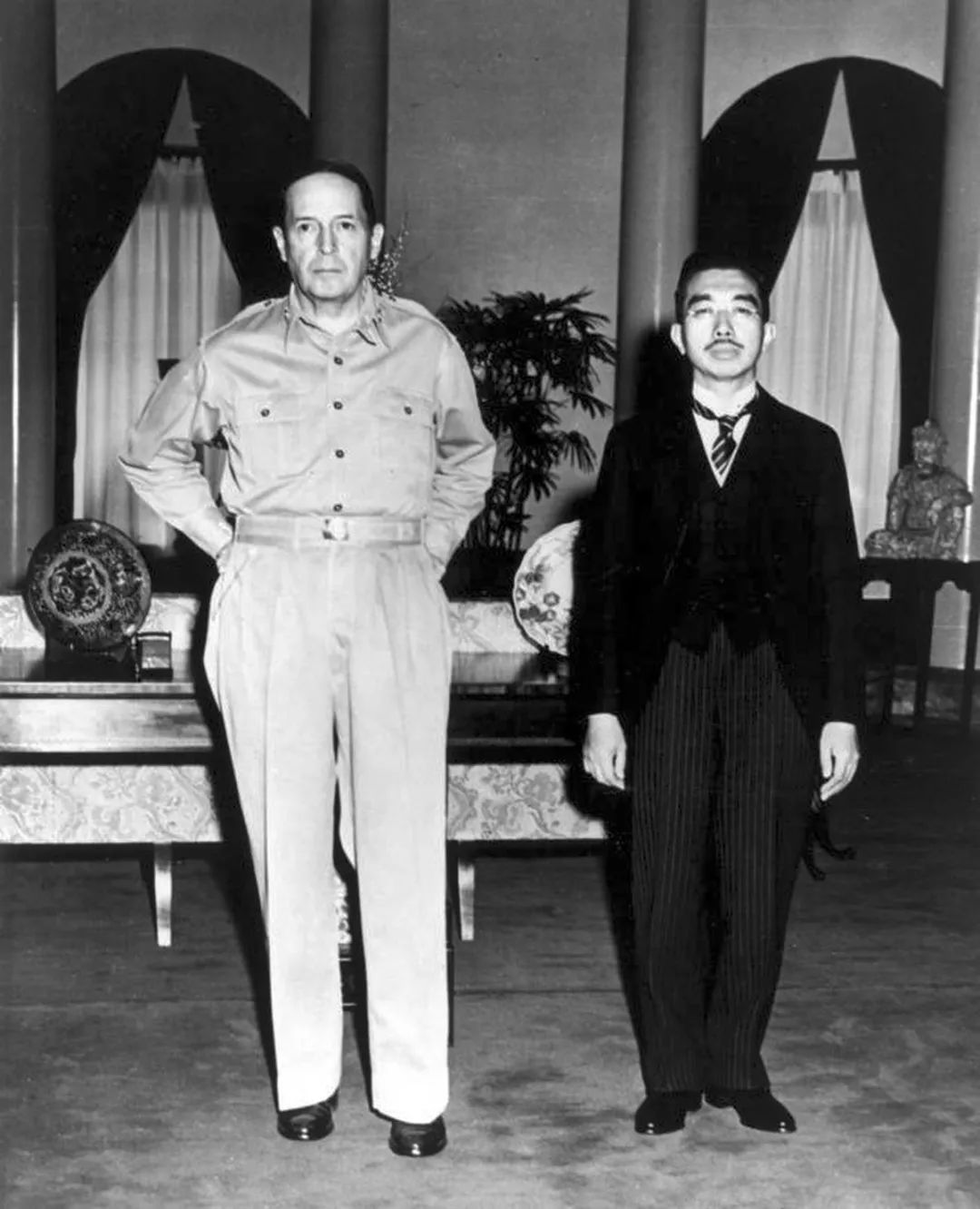
 Japan experienced dramatic political and social transformation under the Allied occupation in 1945–1952. US General Douglas MacArthur, the Supreme Commander of Allied Powers, served as Japan's ''de facto'' leader and played a central role in implementing reforms, many inspired by the New Deal of the 1930s.
The occupation sought to decentralize power in Japan by breaking up the ''zaibatsu'', transferring ownership of agricultural land from landlords to tenant farmers, and promoting labor unionism. Other major goals were the demilitarization and democratization of Japan's government and society. Japan's military was disarmed, Japanese colonial empire, its colonies were granted independence, the Peace Preservation Law and Tokkō were abolished, and the International Military Tribunal of the Far East tried war criminals. The Cabinet of Japan, cabinet became responsible not to the Emperor but to the elected National Diet. The Emperor was permitted to remain on the throne, but was ordered to Humanity Declaration, renounce his claims to divinity, which had been a pillar of the State Shinto system. Japan's new constitution came into effect in 1947 and guaranteed civil liberties, labor rights, and women's suffrage, and through Article 9 of the Japanese Constitution, Article 9, Japan renounced its right to go to war with another nation.
The San Francisco Peace Treaty of 1951 officially normalized relations between Japan and the United States. The occupation ended in 1952, although the US continued to United States Civil Administration of the Ryukyu Islands, administer a number of the Ryukyu Islands. In 1968, the Ogasawara Islands were returned from US occupation to Japanese sovereignty. Japanese citizens were allowed to return. Okinawa was the last to 1971 Okinawa Reversion Agreement, be returned in 1972. The US continues to operate military bases throughout the Ryukyu Islands, mostly on Okinawa, as part of the Treaty of Mutual Cooperation and Security between the United States and Japan, US-Japan Security Treaty.
Japan experienced dramatic political and social transformation under the Allied occupation in 1945–1952. US General Douglas MacArthur, the Supreme Commander of Allied Powers, served as Japan's ''de facto'' leader and played a central role in implementing reforms, many inspired by the New Deal of the 1930s.
The occupation sought to decentralize power in Japan by breaking up the ''zaibatsu'', transferring ownership of agricultural land from landlords to tenant farmers, and promoting labor unionism. Other major goals were the demilitarization and democratization of Japan's government and society. Japan's military was disarmed, Japanese colonial empire, its colonies were granted independence, the Peace Preservation Law and Tokkō were abolished, and the International Military Tribunal of the Far East tried war criminals. The Cabinet of Japan, cabinet became responsible not to the Emperor but to the elected National Diet. The Emperor was permitted to remain on the throne, but was ordered to Humanity Declaration, renounce his claims to divinity, which had been a pillar of the State Shinto system. Japan's new constitution came into effect in 1947 and guaranteed civil liberties, labor rights, and women's suffrage, and through Article 9 of the Japanese Constitution, Article 9, Japan renounced its right to go to war with another nation.
The San Francisco Peace Treaty of 1951 officially normalized relations between Japan and the United States. The occupation ended in 1952, although the US continued to United States Civil Administration of the Ryukyu Islands, administer a number of the Ryukyu Islands. In 1968, the Ogasawara Islands were returned from US occupation to Japanese sovereignty. Japanese citizens were allowed to return. Okinawa was the last to 1971 Okinawa Reversion Agreement, be returned in 1972. The US continues to operate military bases throughout the Ryukyu Islands, mostly on Okinawa, as part of the Treaty of Mutual Cooperation and Security between the United States and Japan, US-Japan Security Treaty.
Postwar growth and prosperity
 Shigeru Yoshida served as Prime Minister of Japan, prime minister in 1946–1947 and 1948–1954, and played a key role in guiding Japan through the occupation. His policies, known as the Yoshida Doctrine, proposed that Japan should forge a tight relationship with the United States and focus on developing the economy rather than pursuing a proactive foreign policy. Yoshida was one of the List of Prime Ministers of Japan#Rank by tenure, longest serving prime ministers in Japanese history. Yoshida's Liberal Party (Japan, 1945), Liberal Party merged in 1955 into the new Liberal Democratic Party (LDP), which went on to dominate Japanese politics for the remainder of the Shōwa period.
Although the Japanese economy was in bad shape in the immediate postwar years, an austerity program implemented in 1949 by finance expert Joseph Dodge ended inflation. The Korean War (1950–1953) was a major boon to Japanese business. In 1949 the Yoshida cabinet created the Ministry of International Trade and Industry (MITI) with a mission to promote economic growth through close cooperation between the government and big business. MITI sought successfully to promote manufacturing and heavy industry, and encourage exports. The factors behind Japan's postwar economic growth included technology and quality control techniques imported from the West, close economic and defense cooperation with the United States, non-tariff barriers to imports, restrictions on labor unionization, long work hours, and a generally favorable global economic environment. Japanese corporations successfully retained a loyal and experienced workforce through the system of Shūshin koyō, lifetime employment, which assured their employees a safe job.
By 1955, the Japanese economy had grown beyond prewar levels, and by 1968 it had become the second largest capitalist economy in the world. The gross national product, GNP expanded at an annual rate of nearly 10% from 1956 until the 1973 oil crisis slowed growth to a still-rapid average annual rate of just over 4% until 1991. Life expectancy rose and Japan's population increased to 123 million by 1990. Ordinary Japanese people became wealthy enough to purchase a wide array of consumer goods. During this period, Japan became the world's largest manufacturer of automobiles and a leading producer of electronics. Japan signed the Plaza Accord in 1985 to depreciate the US dollar against the yen and other currencies. By the end of 1987, the Nikkei 225, Nikkei stock market index had doubled and the Tokyo Stock Exchange became the largest in the world. During Japanese asset price bubble, the ensuing economic bubble, stock and real-estate loans grew rapidly.
Japan became a member of the United Nations in 1956 and further cemented its international standing in 1964, when it hosted the 1964 Summer Olympics, Olympic Games in Tokyo. Japan was a close ally of the United States during the Cold War, though this alliance did not have unanimous support from the Japanese people. As requested by the United States, Japan reconstituted its army in 1954 under the name Japan Self-Defense Forces (JSDF), though some Japanese insisted that the very existence of the JSDF was a violation of Article 9 of Japan's constitution. In 1960, the massive Anpo protests saw hundreds of thousands of citizens take to the streets in opposition to the Treaty of Mutual Cooperation and Security between the United States and Japan, US-Japan Security Treaty. Japan successfully normalized relations Soviet–Japanese Joint Declaration of 1956, with the Soviet Union in 1956, despite Kuril Islands dispute, an ongoing dispute over the ownership of the Kuril Islands, and Treaty on Basic Relations between Japan and the Republic of Korea, with South Korea in 1965, despite Liancourt Rocks dispute, an ongoing dispute over the ownership of the islands of Liancourt Rocks. In accordance with US policy, Japan recognized the Republic of China on Taiwan as the legitimate government of China after World War II, though Japan switched its recognition to the People's Republic of China in 1972.
Among cultural developments, the immediate post-occupation period became a golden age for Cinema of Japan, Japanese cinema. The reasons for this include the abolition of government censorship, low film production costs, expanded access to new film techniques and technologies, and huge domestic audiences at a time when other forms of recreation were relatively scarce. On 1 October 1964, Japan's first high-speed rail line was built called the Tokaido Shinkansen. It is also the oldest high-speed rail system in the world.
Shigeru Yoshida served as Prime Minister of Japan, prime minister in 1946–1947 and 1948–1954, and played a key role in guiding Japan through the occupation. His policies, known as the Yoshida Doctrine, proposed that Japan should forge a tight relationship with the United States and focus on developing the economy rather than pursuing a proactive foreign policy. Yoshida was one of the List of Prime Ministers of Japan#Rank by tenure, longest serving prime ministers in Japanese history. Yoshida's Liberal Party (Japan, 1945), Liberal Party merged in 1955 into the new Liberal Democratic Party (LDP), which went on to dominate Japanese politics for the remainder of the Shōwa period.
Although the Japanese economy was in bad shape in the immediate postwar years, an austerity program implemented in 1949 by finance expert Joseph Dodge ended inflation. The Korean War (1950–1953) was a major boon to Japanese business. In 1949 the Yoshida cabinet created the Ministry of International Trade and Industry (MITI) with a mission to promote economic growth through close cooperation between the government and big business. MITI sought successfully to promote manufacturing and heavy industry, and encourage exports. The factors behind Japan's postwar economic growth included technology and quality control techniques imported from the West, close economic and defense cooperation with the United States, non-tariff barriers to imports, restrictions on labor unionization, long work hours, and a generally favorable global economic environment. Japanese corporations successfully retained a loyal and experienced workforce through the system of Shūshin koyō, lifetime employment, which assured their employees a safe job.
By 1955, the Japanese economy had grown beyond prewar levels, and by 1968 it had become the second largest capitalist economy in the world. The gross national product, GNP expanded at an annual rate of nearly 10% from 1956 until the 1973 oil crisis slowed growth to a still-rapid average annual rate of just over 4% until 1991. Life expectancy rose and Japan's population increased to 123 million by 1990. Ordinary Japanese people became wealthy enough to purchase a wide array of consumer goods. During this period, Japan became the world's largest manufacturer of automobiles and a leading producer of electronics. Japan signed the Plaza Accord in 1985 to depreciate the US dollar against the yen and other currencies. By the end of 1987, the Nikkei 225, Nikkei stock market index had doubled and the Tokyo Stock Exchange became the largest in the world. During Japanese asset price bubble, the ensuing economic bubble, stock and real-estate loans grew rapidly.
Japan became a member of the United Nations in 1956 and further cemented its international standing in 1964, when it hosted the 1964 Summer Olympics, Olympic Games in Tokyo. Japan was a close ally of the United States during the Cold War, though this alliance did not have unanimous support from the Japanese people. As requested by the United States, Japan reconstituted its army in 1954 under the name Japan Self-Defense Forces (JSDF), though some Japanese insisted that the very existence of the JSDF was a violation of Article 9 of Japan's constitution. In 1960, the massive Anpo protests saw hundreds of thousands of citizens take to the streets in opposition to the Treaty of Mutual Cooperation and Security between the United States and Japan, US-Japan Security Treaty. Japan successfully normalized relations Soviet–Japanese Joint Declaration of 1956, with the Soviet Union in 1956, despite Kuril Islands dispute, an ongoing dispute over the ownership of the Kuril Islands, and Treaty on Basic Relations between Japan and the Republic of Korea, with South Korea in 1965, despite Liancourt Rocks dispute, an ongoing dispute over the ownership of the islands of Liancourt Rocks. In accordance with US policy, Japan recognized the Republic of China on Taiwan as the legitimate government of China after World War II, though Japan switched its recognition to the People's Republic of China in 1972.
Among cultural developments, the immediate post-occupation period became a golden age for Cinema of Japan, Japanese cinema. The reasons for this include the abolition of government censorship, low film production costs, expanded access to new film techniques and technologies, and huge domestic audiences at a time when other forms of recreation were relatively scarce. On 1 October 1964, Japan's first high-speed rail line was built called the Tokaido Shinkansen. It is also the oldest high-speed rail system in the world.
Heisei period (1989–2019)
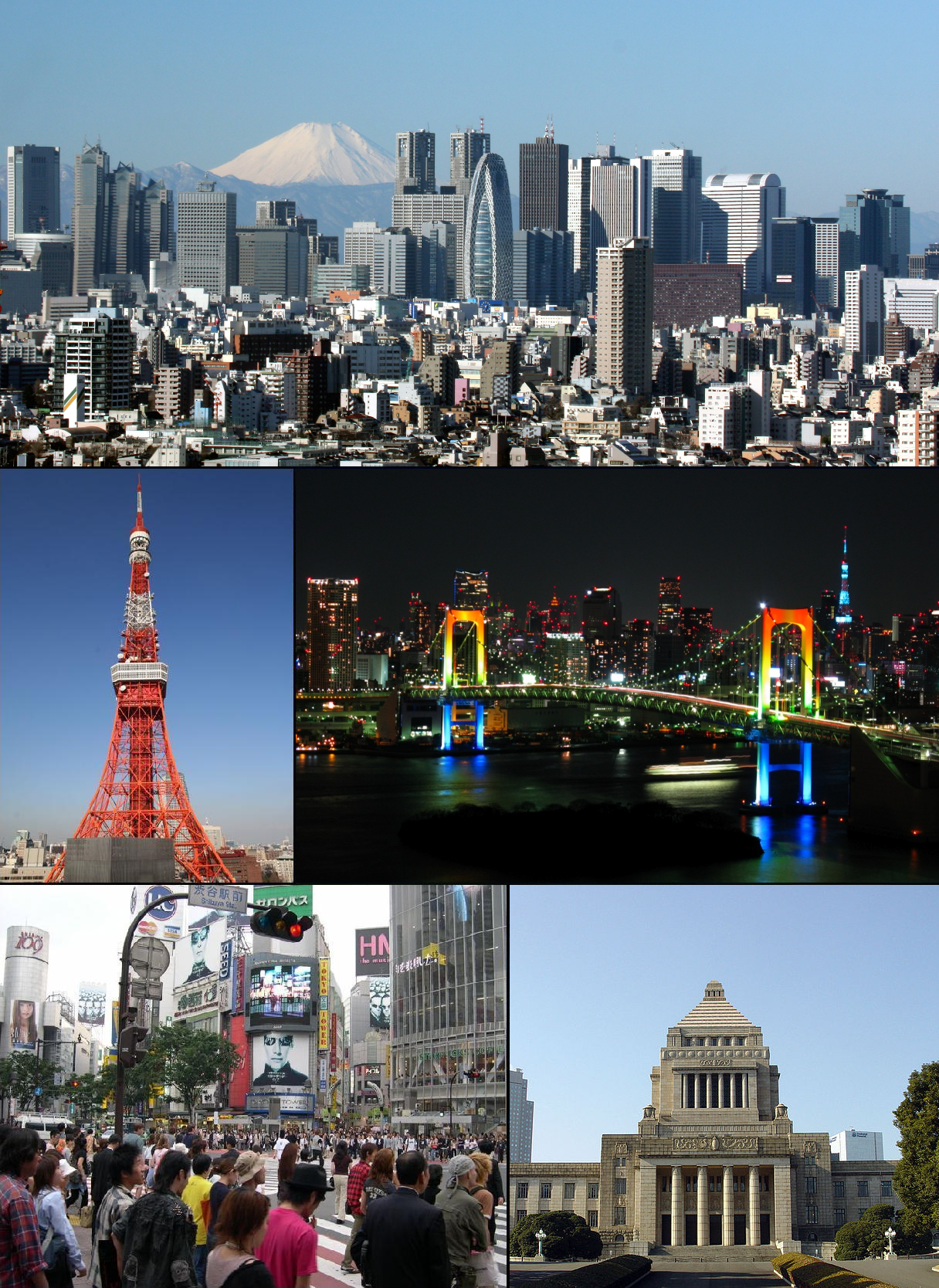 Emperor Akihito's reign began upon the death of his father, Emperor
Emperor Akihito's reign began upon the death of his father, Emperor  The Demographics of Japan, population of Japan peaked at 128,083,960 in 2008. It had decreased by 2,373,960 by December 2020.Japan Statistical Agency monthly Population Estimate. In 2011, the economy of China became the world's second largest. Japan's economy descended to third largest by nominal GDP. Despite Japan's economic difficulties, this period also saw Japanese popular culture, including Video gaming in Japan, video games, anime, and manga, expanding worldwide, especially among young people. In March 2011, the Tokyo Skytree became the List of tallest towers in the world, tallest tower in the world at , displacing the Canton Tower. It is the second tallest structure in the world after the Burj Khalifa ().
On 11 March 2011, List of earthquakes in Japan, one of the largest earthquakes recorded in Japan 2011 Tōhoku earthquake and tsunami, occurred in the northeast. The resulting tsunami Fukushima Daiichi nuclear disaster, damaged the nuclear facilities in Fukushima, which suffered a nuclear meltdown and severe radiation leakage.
The Demographics of Japan, population of Japan peaked at 128,083,960 in 2008. It had decreased by 2,373,960 by December 2020.Japan Statistical Agency monthly Population Estimate. In 2011, the economy of China became the world's second largest. Japan's economy descended to third largest by nominal GDP. Despite Japan's economic difficulties, this period also saw Japanese popular culture, including Video gaming in Japan, video games, anime, and manga, expanding worldwide, especially among young people. In March 2011, the Tokyo Skytree became the List of tallest towers in the world, tallest tower in the world at , displacing the Canton Tower. It is the second tallest structure in the world after the Burj Khalifa ().
On 11 March 2011, List of earthquakes in Japan, one of the largest earthquakes recorded in Japan 2011 Tōhoku earthquake and tsunami, occurred in the northeast. The resulting tsunami Fukushima Daiichi nuclear disaster, damaged the nuclear facilities in Fukushima, which suffered a nuclear meltdown and severe radiation leakage.
Reiwa period (2019–present)
Emperor Naruhito's reign began upon the abdication of his father, Emperor Akihito, on 1 May 2019. In 2020, Tokyo was due to host the 2020 Summer Olympics, Summer Olympics for the second time since 1964. Japan was the first Asian country to host the Olympics twice. However, due to the global outbreak and economic impact of COVID-19 pandemic in Japan, COVID-19 pandemic, the Summer Olympics were postponed to 2021; they took place from 23 July to 8 August 2021. Japan ranked third place, with 27 gold medals. When the 2022 Russian invasion of Ukraine began, Japan condemned and levied sanctions on Russia for its actions. Ukrainian President Volodymyr Zelenskyy praised Japan as the "first Asian nation that has begun exerting pressure on Russia." Japan froze the assets of Russia's central bank and other major Russian banks and assets owned by 500 Russian citizens and organizations. Japan banned new investments and the export of high tech to the country. Russia's trade status as Most favoured nation, favored nation was revoked. Japan's swift actions shows its becoming a leading power in the world. The war in Ukraine and threats from China and North Korea caused a shift in Japan's security policy with higher defense spending which erodes its former pacifist stance. On 8 July 2022, former Prime Minister Shinzo Abe, was Assassination of Shinzo Abe, assassinated in the city ofSocial conditions
Social stratification in Japan became pronounced during the Yayoi period. Expanding trade and agriculture increased the wealth of society, which was increasingly monopolized by social elites. By 600 AD, a class structure had developed which included court aristocrats, the families of local magnates, commoners, and slaves. Over 90% were commoners, who included farmers, merchants, and artisans. During the late Heian period, the governing elite consisted of three classes. The traditional aristocracy shared power with Buddhist monks and samurai, though the latter became increasingly dominant in the Kamakura and Muromachi periods. These periods witnessed the rise of the merchant class, which diversified into a greater variety of specialized occupations. Women initially held social and political equality with men, and archaeological evidence suggests a prehistorical preference for female rulers in western Japan. Female Emperors appear in recorded history until the Meiji Constitution declared strict male-only ascension in 1889. Chinese Confucian-style patriarchy was first codified in the 7th–8th centuries with the ''See also
* Economic history of Japan * Higashiyama period * Historiography of Japan ** Bibliography of Japanese history **''Bulletin of the National Museum of Japanese History'', in Japanese **''Japanese Journal of Religious Studies'' **''Journal of Japanese Studies'' **''Monumenta Nipponica'', Japanese studies, in English **''Social Science Japan Journal'' * History of East Asia * Japanese art#History of Japanese art, History of Japanese art * History of Japanese foreign relations ** Foreign relations of Meiji Japan ** Greater East Asia Co-Prosperity Sphere, 1930–1945 ** History of Japan–Korea relations ** History of Sino-Japanese relations, China ** Japanese foreign policy on Southeast Asia ** Japan–Soviet Union relations * History of manga * History of Tokyo * List of Emperors of Japan * List of prime ministers of Japan * Timeline of Japanese historyCitations
Cited sources
* * * * *online
* * In * * * * * * * * * * * * * * * * *
Further reading
* Garon, Sheldon. "Rethinking Modernization and Modernity in Japanese History: A Focus on State-Society Relations" ''Journal of Asian Studies'' 53#2 (1994), pp. 346–366. . * Hara, Katsuro. ''Introduction to the history of Japan'' (2010online
* Hook, Glenn D. et al. ''Japan's International Relations: Politics, Economics and Security'' (2011
excerpt
* * * Kingston, Jeffrey. ''Japan in transformation, 1952-2000'' (Pearson Education, 2001). 215pp; brief history textbook * Kitaoka, Shin’ichi. ''The Political History of Modern Japan: Foreign Relations and Domestic Politics'' (Routledge 2019) * * Tames, Richard, et al. ''A traveller's history of Japan'' (2008), popular histor
online
External links
* * {{Prehistoric technology History of Japan, Articles containing video clips Japanese culture Japanese nationalism Politics of Japan